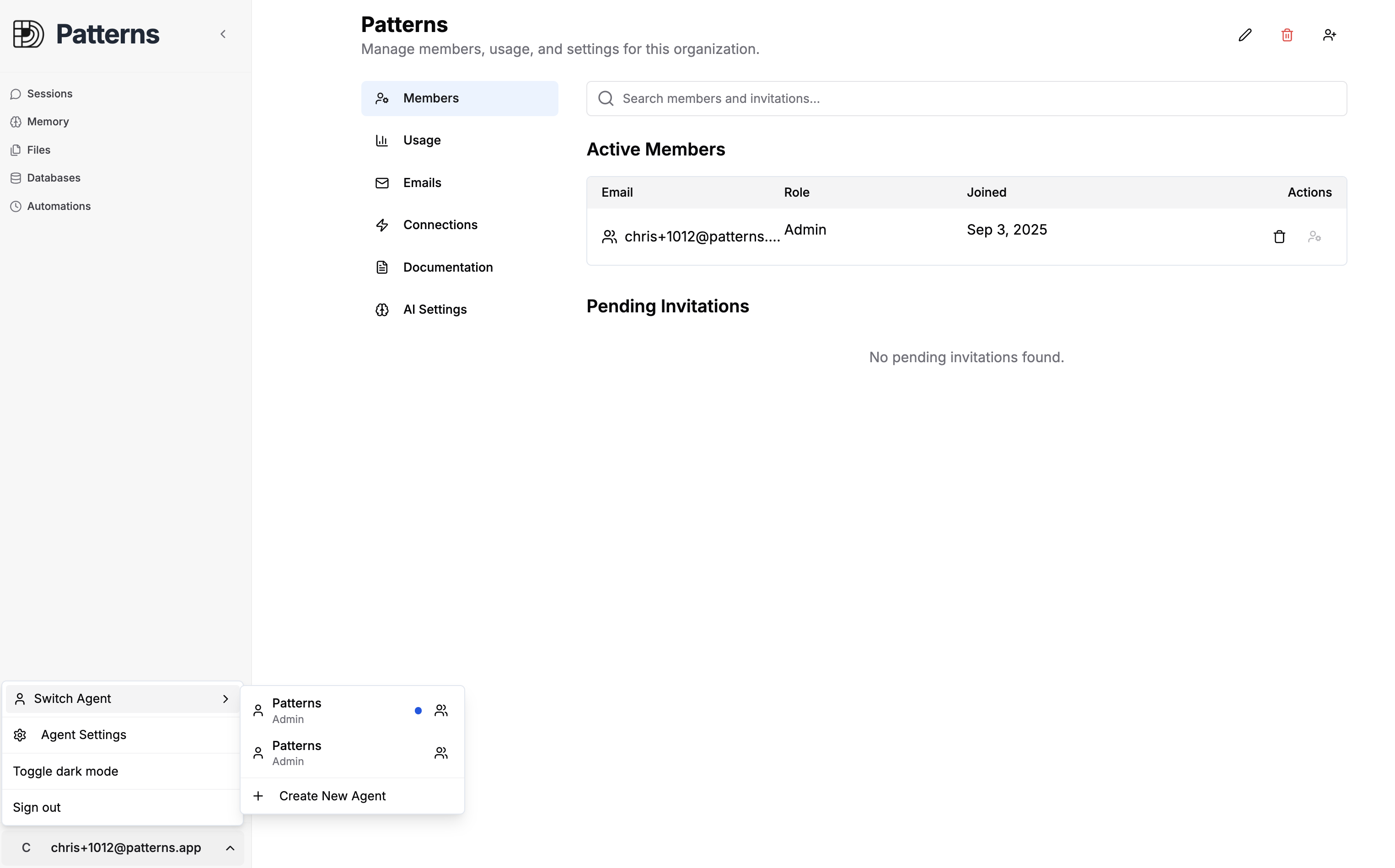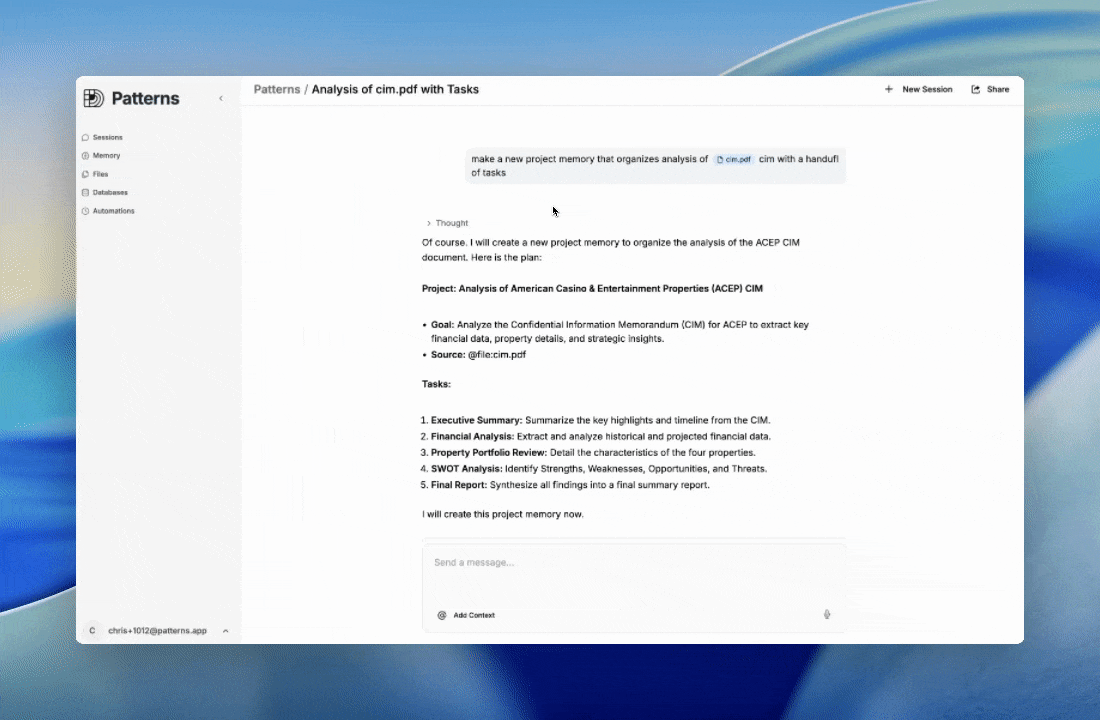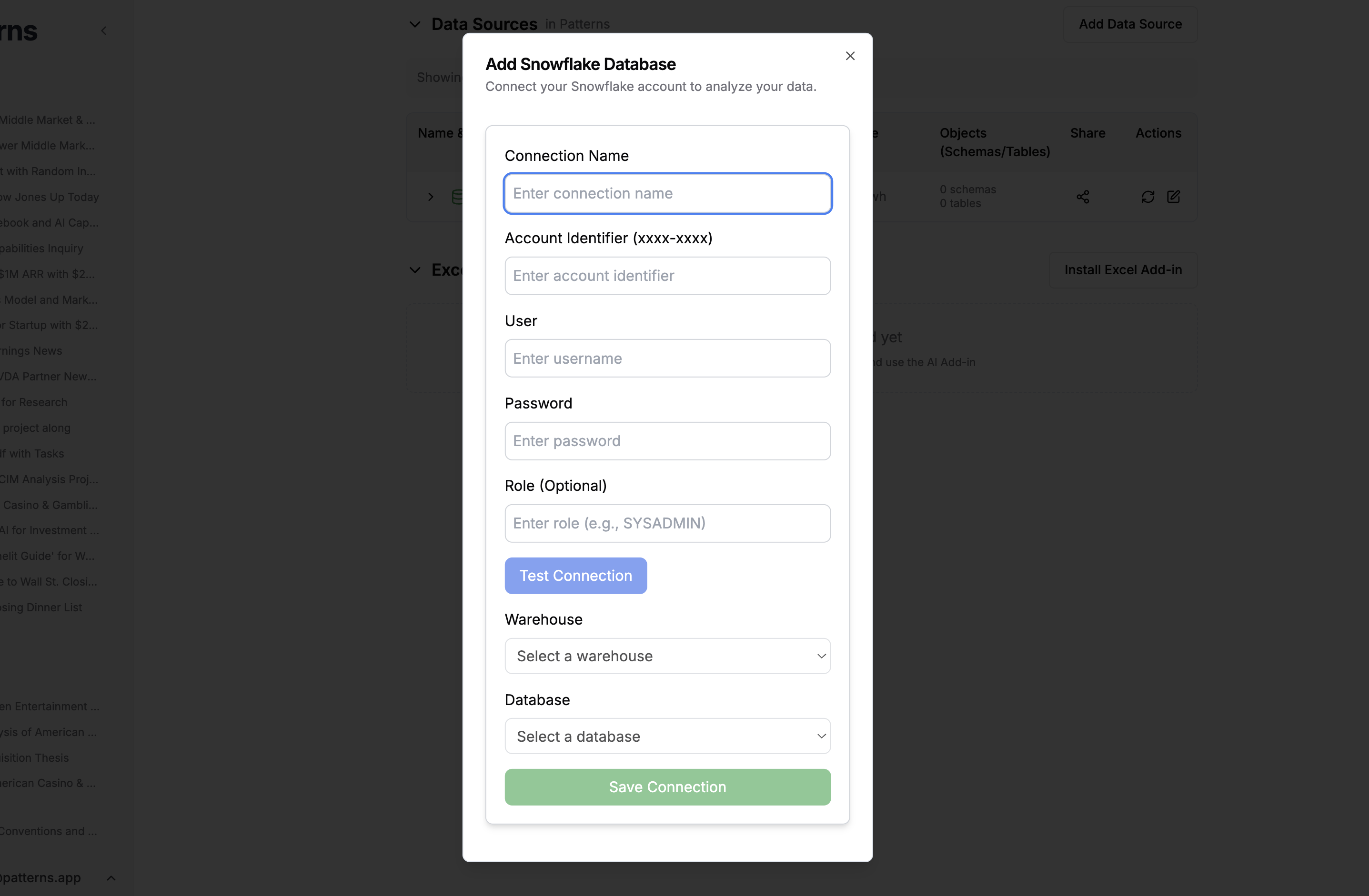Patterns AI for Deal Teams — User Guide
This guide explains how to use the application to produce analyst-grade deliverables across the deal process (comps, buyer lists, models, memos) with an agentic workflow designed for investment bankers. For context on value proposition and pricing, see: Patterns and Patterns Pricing.
Key Concepts
Agents — Workspaces for teams with their own data, memory, and chats.
Chats — Task-oriented conversations where the AI executes your playbooks.
Files — PDFs, Excel, CSVs; system indexes content for retrieval.
Excel — Bi-directional sync via add-in; create/read/write from chats or notebooks.
Python — Persistent runtime with pandas/Altair for analysis and visualization.
Notebooks — Reproducible Python/Markdown cells; assets and charts render in-app.
Databases — Connect Snowflake, BigQuery, Postgres; query from Python or tools.
Web Research — Agentic research via Exa for market/industry/company sources.
Memory/Projects/Todos — Save templates, manage work, and track progress.
Automations — Scheduled or manual tasks to run playbooks autonomously.
Agents
What agents are
Agents are team workspaces with their own data sources, knowledge base, and chat history. Each user gets a default personal agent; you can create additional agents for deals, sectors, or clients.
Creating agents
Navigate to lower left menu in the sidebar and select New Agent. Name and optionally describe the agent; it initializes with a clean knowledge base.
Agent members
Add members by email from the agent's Members page. Roles: Admin can manage members and settings; members can use all analysis tools and shared resources. Runtime capabilities are the same; admin adds/removes users and manages integrations.
Data, memory, session history
Each agent keeps its own files, memories, and chat sessions. Sharing is scoped to the agent unless explicitly made public (see Sharing).

Chat Sessions
Context and intent
The AI is instructed to act as a PE analyst focused on execution with your data and tools. Be explicit about data sources and expected outputs (e.g., "Refresh public comps for vertical SaaS, output table in Excel and write back formulas"). The AI will ask clarifying questions when needed.
AI models and context limits
Choose a model in Settings; the app remembers your selection for future chats. Long chats may hit a model's context limit. Use Session Bridging to continue.
Using @mentions to add context
Type @ in the message box to search your resources and insert mentions. Supported types commonly include: files, notebooks, databases/tables, knowledge/memories, chats, and tasks. Mentions pin authoritative context to your request so the AI cites and uses the right sources.
Session bridging (continue when context is full)
Use "Summarize & Continue" to roll forward: the app writes a brief summary of the current thread and opens a new chat with that state carried over. Use when context is near limits, you want a clean thread, or after large tool runs.
Edit and revert session changes
You can edit your last user message. If tool actions occurred afterward, reverting will roll back subsequent steps in this chat. Reverts will also undo AI-initiated changes tracked in this thread (including Excel writes that were performed via the session). Confirm before proceeding.
Prompt tips
- • Align on a plan first: "Plan the approach to refresh comps and draft IC outline."
- • Specify sources: "Use Snowflake schema X, PitchBook export, File: 'Q2 KPI.xlsx'"
- • Specify outputs: "Write results to Excel tab 'Comps', include valuation bands"
- • If the direction is off: stop, revert to the prior step, and re-prompt.
Sharing and embedding chats
Use the Share button in the chat header to copy a view-only link. Public share links render a read-only version without requiring sign-in. For internal distribution, set visibility to your agent and share in Slack/Teams.

Files
Supported file types
PDFs, XLSX, CSV (CSV is converted to XLSX under the hood for consistency). PPT support is on the roadmap. Contact us for additional formats.
Loading files
Drag and drop into a chat, or upload via Files. Reference specific files in prompts via @mentions for precise context.
Data extraction, indexing, and search
PDFs are indexed for page-level search; Excel sheets are summarized for quick previews. Use @mentions to ensure the AI cites the exact document or sheet.
Review extractions
For PDFs: open the file to preview extracted structure; cite specific pages. For Excel: view sheet list and headers; the AI can read ranges or write results.
Excel
Create / read / write
Ask the AI to create a new workbook, read a range, or write a 2D array to Sheet!A1. The write tool auto-sizes ranges and pads jagged arrays.
Formatting basics
You can request tables with headers, basic number formats, and new worksheets. The system preserves data types and dates when possible.
Excel add-in (bi-directional sync)
Connect the add-in to sync changes from Excel to the app and vice versa in near-real-time. "Force Sync" will snapshot current sheets to the server and re-index content.
Connect the Excel add-in
To connect the add-in, download the manifest and upload it in Excel. Please see the video for details.
Sync changes
After AI writes to Excel, changes appear in your workbook; add-in logs updates. If needed, you can revert chat steps that wrote to Excel from within the chat.
Python
Run code
Use the notebook or quick Python execution to run analysis without leaving chat.
Libraries available
pandas, numpy, Altair (for charts), statsmodels, openpyxl, and standard libs.
Datastore
store.set(key, df) saves a DataFrame (or chart) as a named asset for reuse.store.get(key) retrieves the asset in later Python or Excel steps.
Database and files in Python
query_database(data_source_id, sql) returns a DataFrame for SELECT/DDL/DML.load_file_by_id(file_id) returns bytes you can pass directly to pandas/openpyxl.
Code examples:
# Load Excel and preview
file_data = load_file_by_id("FILE_ID")
import pandas as pd
df = pd.read_excel(file_data, sheet_name="Sheet1", nrows=50)
store.set("sample", df)
# Query database
my_ds = "ds_XXXXXXXXXX"
sql = "SELECT name, revenue FROM finance.customers WHERE region='US' LIMIT 100"
df2 = query_database(my_ds, sql)
store.set("customers_us", df2)
# Chart with Altair (charts render when stored)
import altair as alt
alt.data_transformers.enable('default', max_rows=None)
chart = alt.Chart(df2).mark_bar().encode(x='name:N', y='revenue:Q')
store.set('customers_chart', chart)Notebooks
What they're for
Structured, reproducible analysis with Python and Markdown cells. Use notebooks to document research, attach citations, and produce charts/tables.
Cells (Python or Markdown)
Add, update, or delete cells freely. Python cells can auto-execute; Markdown cells render instantly. Charts render when saved via store.set('key', chart); tables render from stored DataFrames. Console output appears alongside cells for transparency.
Databases
Supported systems
Snowflake, BigQuery, Postgres (via configured data sources).
Schema indexing and sampling
Browse available tables and columns; the AI can sample data to infer schema usage.
Agent data tools
Use tools to list tables, read from a view, or materialize intermediate results.
Access via Python VM
Use query_database for SQL inside notebook cells; results become DataFrames for downstream analysis and Excel output.
Fivetran
Managed ingestion for common SaaS/data sources. Configure destinations, groups, and connections to route data into your warehouse.
Currently supported connectors (examples)
Brew (beta), QuickBooks, Gmail. Contact support for additional connectors and enterprise sources.

Web Research
What it does
Agentic multi-step research for market maps, industry analysis, and comps across many websites. Progress streams live; results include a structured summary or JSON if a schema is provided.
Typical uses
Refresh public/precedent comps, build buyer universes, draft memo sections with citations.
Notes
Long tasks have a sensible timeout; break very large prompts into smaller chunks if needed.
Other Data Sources
Crunchbase, People Data Labs, PitchBook, SourceScrub: bring exports as files, connect via warehouse tables, or leverage web research for public context.
Memory & Automations
Memory
Save reusable templates, stylistic guides, and project context as memories.
Projects
Maintain a single "project" memory per effort with goal, scope, and a punch-list of tasks; attach deliverables and files.
Todos
Keep a lightweight todo memory while working a task; delete it when done.
Custom tags
Tag memories/files for quick discovery (e.g., tag=project or sector tags) and better @mention filtering.
Automations (Tasks)
Self-contained runs that execute playbooks on a schedule or on-demand (e.g., weekly comps refresh that writes back to Excel and posts a summary). Create automation → name it → choose recurring or one-time schedule (CRON) or leave unscheduled for manual runs → provide clear instructions and outputs.

Citations
What gets cited
The AI includes citations in outputs so reviewers can validate sources. Common citations reference: PDFs with page numbers, Excel ranges/sheets, and web pages.
How to add or ensure citations
In chats: use @mentions to anchor the exact files/tables; the AI will cite those sources in its response. In notebooks (Markdown cells): include a brief reference at the end of a sentence or immediately after a quote.
Examples:
Revenue increased 18% YoY in Q3. [PDF: Q3-Report, p. 15]
We used the model sheet for calculations. [Excel: Forecast!A1:D50]
Industry overview adapted from Gartner. [https://www.gartner.com]
Tips:
- • Place citations right after the sentence they support; quotes should cite immediately after the quote, paraphrases at sentence end.
- • Prefer specific locations (page numbers or ranges) over broad document mentions.
- • Use @mentions in chat prompts to make the AI pick the right sources before it writes.
Best Practices
- Be explicit: State data sources, filters, and expected outputs.
- Cite and pin: Use @mentions so the AI uses the right files/tables.
- Iterate: Agree on the plan before heavy execution; summarize between phases.
- Validate: Use reviewer gates on outputs; leverage revert when needed.

Additional Context
For product positioning, deployment options, security, and pricing models (Agent Compute Units, onboarding, and services for buy/sell-side), see: